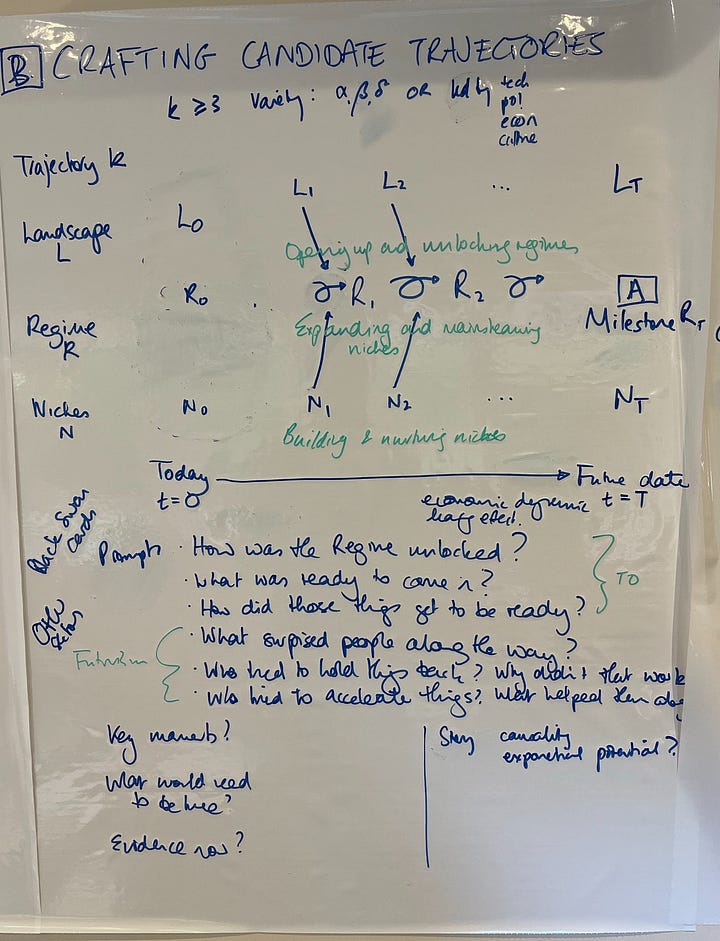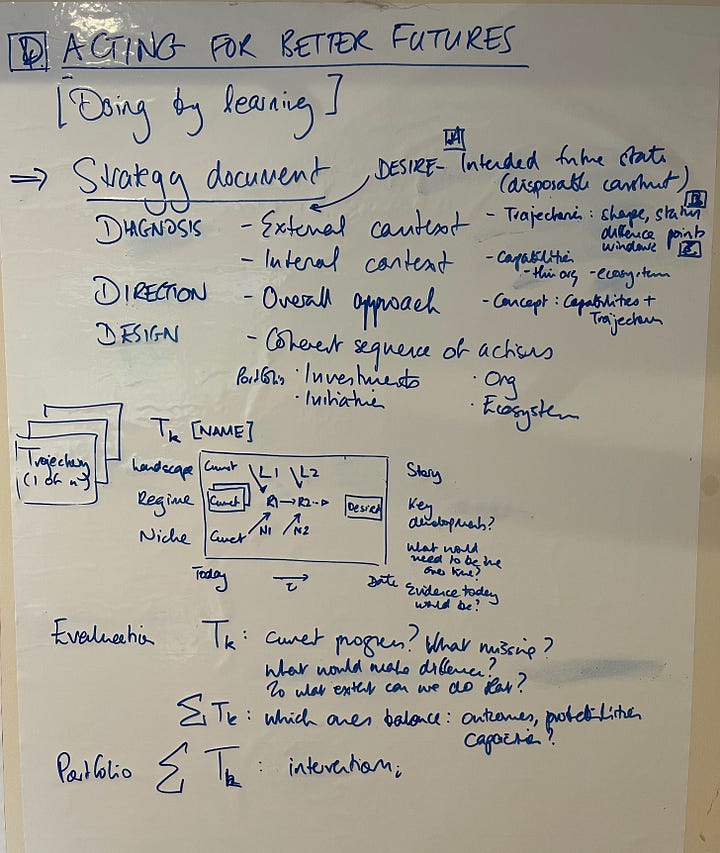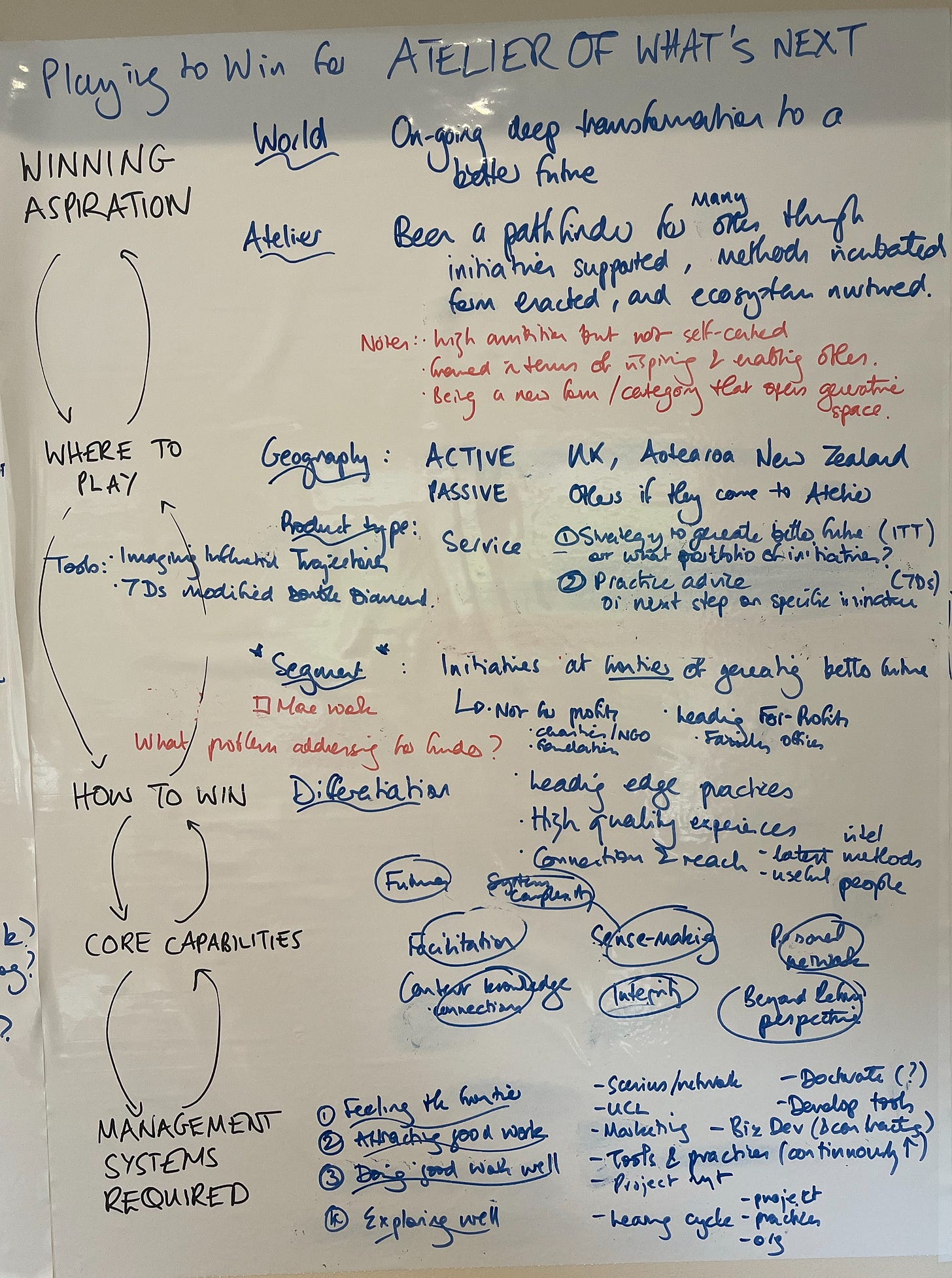Atelier WeekNotes w/c 29 April 2024
PRIORITIES. Atelier strategy: Market research and 'Playing to Win'. OUTPUTS ReadingNotes: ‘Playing to Win’ by Martin & Lafley; Innovation for Sustainability: Anna Birney & the Multi-Level Perspective.
I am writing newsletter of #weeknotes of starting the Atelier of What’s Next (a studio for initiatives at the frontier of generating a better future). For my rationale for starting the Atelier see here.
Slightly late, this week covers:
PRIORITIES
Atelier strategy
Market research
Applying 'Playing to Win’ to the Atelier.
OUTPUTS
ReadingNotes: ‘Playing to Win: How Strategy Really Works’ by Martin and Lafley
Innovation for Sustainability: Anna Birney and the Multi-Level Perspective
How can the Atelier of What's Next be of service to you, and your purposes? We'd love to hear from you. Perhaps you have a challenge or idea to put in the studio. Maybe one of our existing topics appeals to you. What if you love to make new things happen by being part of the studio? Or if you have feedback or comments that would improve this deck. Either click the button below or email davidbent@atelierwhatsnext.org.
PRIORITIES
Atelier strategy
Market research
I had a usefully bracing conversations this week with people who work in the philanthropy space.
There is a gap. There are few organisations trying to do what the Atelier is trying to do (this is with searches using different adjacent terms). Great, and maybe a sign that this is too tough a space to exist in. Also, will mean lots of helping potential funders understand how the Atelier meets their needs.
University might be a better home. Such examples as there are often exist in universities, though usually with a closer focus on a specific domain, and usually limited to producing papers on what should be done (so, not studios). A possibility, maybe as a partner.
Public bodies might be a niche. They have responsibility for a challenge. Great point.
Long-term change needs a long-term champion.
The current intention is for the Atelier itself to have no topic focus, but to specialise in moving things along at the frontier of whatever topic comes along. The Atelier's theory of change is that it can make a significant contribution at a key moment.
That gets the Atelier out of needing deep content expertise and long-term funding. But, the organisations the Atelier is working with will need those. Impact relies on long-term resources and coherent effort. The Atelier will need to consider how those organisations will have the ongoing capability, accountability and adaptability to overcome challenges as they come up.
Great spot and challenge.
Where to play: creating the plan, then convincing people to commit to the plan. I had reached the same conclusions, see section on applying 'Playing to Win' below.
Philanthropic funding unlikely. Foundations will fund things that solve particular problems. The Atelier does not. Though, not impossible they might use the Atelier to come up with how to solve particular problems.
Funders more familiar with 'Lab' (signalling 'a place to experiment'). Atelier name will put people off. Feel quite contrarian on this one. Someone was the first to call their effort in change a 'lab'. I think the metaphor of a studio (where we work on something together) can work. But have to get much less tetchy in how I respond to this kind of point.
Conveying a function is hard. Last week I had a lesson from past strategy clients that it is hard to keep alive your story of being a function in the system. I had the same experience here, with at least one of the people I was speaking to fixing on the topics ('oh, shipping, I know who works in that') rather than on the role.
WHAT NEXT.
Keep collecting bracing feedback.
More iterations needed on who the funder is and what problem solving for them.
Create an advisory board
Applying 'Playing to Win' to the Atelier
I have long admired the book Playing to Win (PTW) by A.G. Lafley and Roger Martin, a rare business book on strategy which is worth the effort. Last week I re-read it (and created the ReadingNote below) as part of the Imagining Influential Trajectories project. Of course, I applied the five questions (see below) to the Atelier, and got these answers:
Winning aspiration
Following Success in 2024:
World: On-going deep transformations towards a better future.
Atelier: Been a path finder for many others to be at the frontier of generating better futures through:
Initiatives helped on their next step (direct impact).
Methods incubated (that others then use).
Form enacted (that others adapt to their circumstances).
Ecosystem nurtured.
[I had put 'contributed to those on-going deep transformations'. But PTW insists on going beyond contributing (which is mediocre and just taking part) and establishing what winning would look like. Hence the more ambitious articulation.]
Where to play
'Initiatives at the frontier of generating a better future', which in practice means:
Organisation type (private, public and civil society) which:
Ambitious for 'deep' change on a specific topic.
Face a predicament (rather than a problem) which has been stubborn to other interventions.
Either:
Stuck on what to do
or
Have an initiative which needs to take the next step
[This definitely needs more work. Too wide a segment.]
Product: service offering:
Strategy to generate a better future. Key tool: Imagining Influential Trajectories.
Working together for initiative to take next step. Key tool: 7Ds modified Double Diamond.
Geography: UK and Aotearoa New Zealand by default.
How to win
Differentiation:
Leading-edge practices and methods.
High quality experiences.
Useful connections and reach (on: intelligence, methods, people).
[Low cost the only other option in general, and not applicable here.]
Core capabilities
Sense-making.
Futures methods.
Systems approaches.
Facilitation and experience design.
Content knowledge built up over time.
Personal connections.
Integrity.
'Deep transformation' perspective and ambition.
Management systems required
Feeling the frontier. Networks. UCL. Doctorate. Developing tools and methods.
Attracting good work. Marketing (including publishing and podcasts). Business development.
Doing good work well. Tools and practices. Project management. Relationship management.
Exploring well. Learning cycle for each of projects, practices and Atelier, at levels of improving, creating new approaches to replace a struggling one and rethinking how to think.
WHAT NEXT. As with the feedback above, more iterations needed on who the funder is and what problem solving for them ('Where to play' in the PTW jargon).
IN THE ATELIER
Imagining Influential Trajectories
Step: 4/DEVELOPING. Theme: Method; Sectoral Transformation; Governance; Futures.
One line: An approach (currently in a development stage) to accelerate change by understanding what is happening now, identifying what will make a difference and inducing coherent action across stakeholders.
Aknowledgment. Very grateful for the opportunity provided by Sustainable Shipping Initiative, and funding from Lloyd's Register Foundation, for the first pilot use in the State of Sustainable Shipping (SoSS).
A week of thinking and designing, and re-thinking and re-designing. The images below will mean very little to you, except as proof that Stuff Got Put On Flipcharts:


OUTPUTS
ReadingNotes: ‘Playing to Win: How Strategy Really Works’ by Martin and Lafley
Playing to Win is an excellent book on business strategy. It comes out of the experiences of A.G. Lafley (formerly CEO of P&G) and Roger Martin (who advised P&G, and is also a leading management academic, including in the growth of design thinking).
The fundamental propositions:
Strategy is the answer to these five interrelated questions:
What is your winning aspiration? The purpose of your enterprise, its motivating aspiration.
Where will you play? A playing field where you can achieve that aspiration.
How will you win? The way you will win on the chosen playing field.
What capabilities must be in place? The set and configuration of capabilities required to win in the chosen way.
What management systems are required? The systems and measures that enable the capabilities and support the choices.
Ultimately, there are four dimensions you need to think about to choose where to play and how to win: the industry; customers; relative position and strengths; and, competition.
You can reach a good decision on a set of choices, which also have greater commitment from the group, using a decision-making that reverse-engineering the choice (and avoiding general production of contextual data to swim through in order to create a strategy).
The crucial question is: "what would need to be true for this choice to be strategically sound?" This should give you a testable hypothesis, which then drives the choice
The kind of dialogue needed for these strategy discussions is not 'propose and defend' but 'assertive inquiry', where individuals need to embrace a particular stance about their role in a discussion...“I have a view worth hearing, but I may be missing something.”
I first read this in 2013 (11 years ago) and really liked it from the start. I found it extremely useful, especially:
The 'what would need to be true?' question, which I used so much that my colleagues from that time use it still as "the David question" (along with "What is the purpose of this meeting? What is the place we need to get to by the end of our time together?").
The 'Imagining Influential Trajectories' method, a combination of systems transition theory, technology roadmapping and more, is in development using the same 'reverse engineering' approach.
The five interrelated questions could be answered by using a variety of better-know analytical frameworks.
While the focus on 'winning aspiration' has value (forcing hard choices) there are circumstances that where the zero-sum ('we win, competitors lose') is less appropriate, especially in the system change space. It also can make for quite a heroic book, where individuals are overcoming problems with their great use of the book's tools.
Even so, one of the foundations of my own strategy practice.
Read more here
Innovation for Sustainability: Anna Birney and the Multi-Level Perspective
Dr Anna Birney is CEO (Chief Executive / Enabling / Evolving Officer) of The School of System Change, which enables personal and collective agency to cultivate change in the world with a multi-method approach to systems change learning – with networks, organisations and individuals (Anna’s LinkedIn, Medium and Twitter).
This episode is a little unusual. We dive into the Multi-Level Perspective (‘MLP’), one of the leading theories of system transition which we teach in the module (here for the Wikipedia explanation). MLP has been used in academic research for the last decade or so. However, there are not a lot of good case studies of using MLP for change.
The #OneLess project, run by Anna when she was at Forum for the Future, is a rare example.
Anna uses slides to explain the story. You can watch the presentation on YouTube immediately below (and here) as well as download the slides here. (Note: the sound quality of the video is poor while the music is playing but settles down after that.)
More here.





